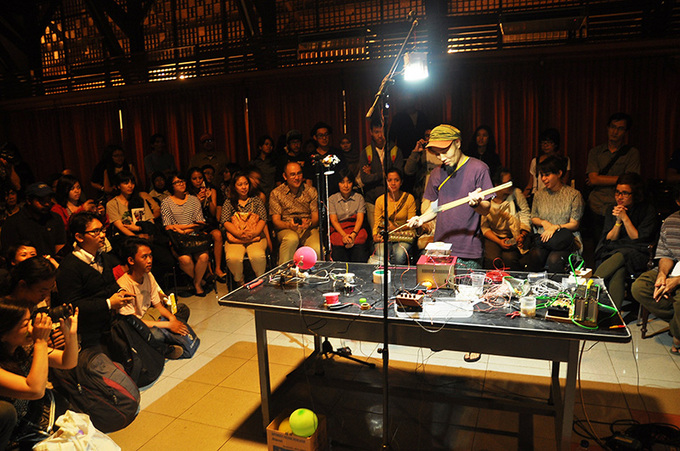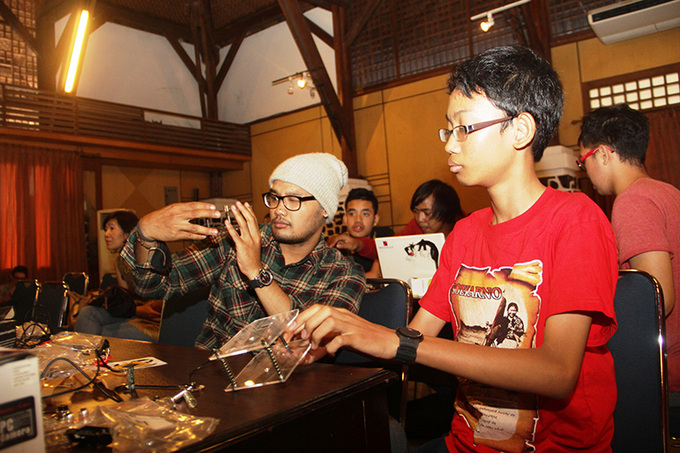"What is Media Art?"--Curators from Japan and Southeast Asia Explore Today's Meaning of Media Art
Keiko Okamura, Curator, Tokyo Metropolitan Museum of Photography
Daiya Aida, Chief Educator, Yamaguchi Center for Arts and Media (YCAM)
Hiroyuki Hattori, Curator, Aomori Contemporary Art Centre (ACAC), Aomori Public University
A group of 13 curators from Japan and six countries in Southeast Asia--Indonesia, Malaysia, Singapore, Thailand, the Philippines, and Vietnam--cooperate to realize exhibitions of media art in the four cities of Jakarta, Kuala Lumpur, Manila, and Bangkok. This was all that had been decided at the time of the kick-off meeting in Tokyo in August 2012.
"What is the nature of media art we should present?" The curators explored this question together and came to agreement on a project framework. That is, it would consist of not only an "exhibition" that displays completed works of art, but also a "workshop" and a "laboratory" that encourage active audience participation and guide the visitors to discover room for creative thinking in their everyday lives. It would incorporate screening programs to complement the individual exhibits and to expand the project beyond the main venues in the four cities. And, as an additional platform, it would operate a website for relaying, recording, and sharing the process leading up to the project.
Accumulating a great deal of passion, skills, and communication
After the kick-off meeting in Tokyo, we three curators from Japan flew to the four venue cities plus Singapore. With the curators there, we looked into candidate venues, artists and artworks, and the situation in the individual areas. Then, in late February 2013, all curators got back together in Tokyo for the second meeting and worked on an exhibition layout for each venue in line with the core concept submitted by us three from Japan.
After a heated discussion, we came up with a title that combines a reinterpretation of media art as "media that is also art" (Media/Art) with a term that stands for the do-it-yourself spirit and invites audience participation (Kitchen).
That was only the first step of a tall order. While the shared concept runs throughout the project, each venue has a unique sub-theme that revolves around a different lineup of artists and artworks. Not only that, but we 13 curators were also to plan and execute the exhibitions in the all four cities, simultaneously, within a preparation time of less than a year. Between the approval of the basic plan and the opening of the first exhibition, we had just short of five months. It initially seemed to be unrealistic, but the project has just begun to take shape with the September 2013 launch of the Jakarta edition of "Media/Art Kitchen--Reality Distortion Field."
What's going to continue making the impossible possible is none other than the great deal of passion and skills each of us curators puts into the project, and the communication that fuses all that into one big effort. We all live in the media environment, and for this project share the itch to make a critical, creative proposal in that sphere of our daily lives. And yet somehow, those of us based in different parts of the world--even we three are from Aomori, Tokyo, and Yamaguchi, in remote corners of Japan--feel forced to better exploit the Internet-based services, programs, devices, and other technologies that should be familiar to us. We take this as an interesting issue to think about through the project.
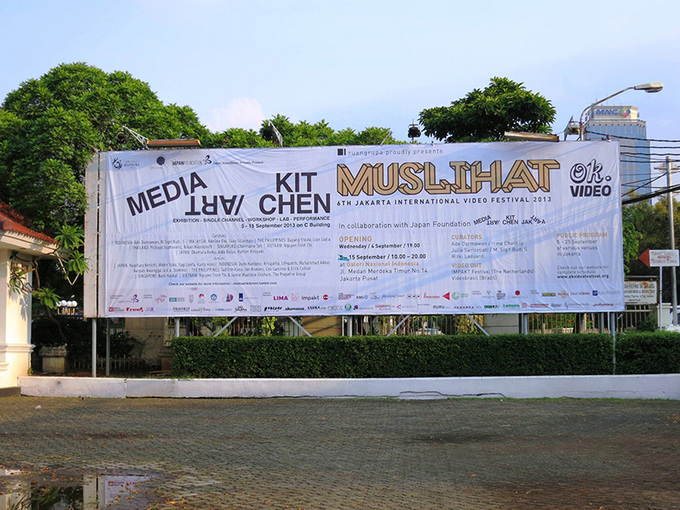
Large signboard at the entrance of Galeri Nasional Indonesia
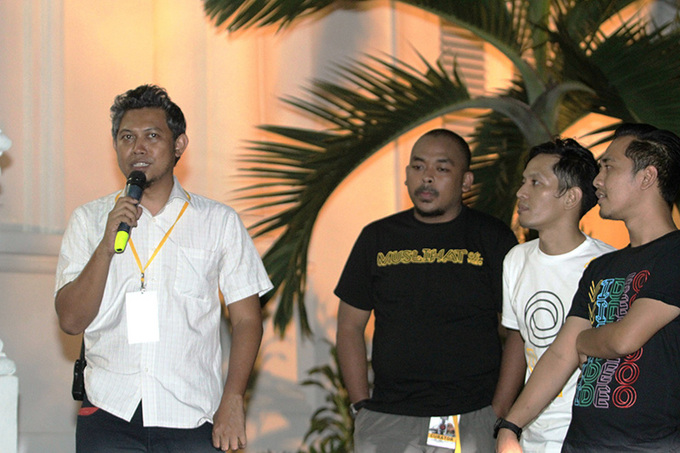
(From left) The participating curators from Indonesia, Ade Darmawan and M. Sigit Budi S, and artists Narpati Awangga and Angga Nggok

(Left) The venue, Galeri Nasional Indonesia, (Right) Artist talk event with Kanta Horio and Yuko Mohri
To Jakarta, Kuala Lumpur, and Manila
Here, let's give an outline of the exhibitions in the four different cities. The Jakarta exhibition teams up with the OK. Video Festival (Jakarta International Video Festival), held every two years since 2003, under the theme "Consumer VS the Power of Industry: Society who Criticize Technology." It features artists who question the enormous, automated production system and tackle the creative process at times from a critical point of view, by hand, without being a slave to technology.
The Kuala Lumpur exhibition takes place in galleries and theatrical spaces dotting the shopping mall in a new housing complex, and thus collaborates with art universities to enhance an educational aspect of the project for visitors new to "media/art." Under the theme "extra/ordinary," it introduces works that reflect the residential environment and surrounding situation in a new setting, with a focus on the technologies that make this possible. An array of workshops and labs is in store to prompt active audience engagement in the exhibition.
The Manila exhibition, with the theme "Sensorium," focuses on physical experiences. It appeals to the sense of sight and hearing with sounds and images, and further defamiliarizes the venue itself with scents and textures, creating a space for visitors to feel with the entire body. The main exhibition venue is the Ayala Museum, in the heart of the city. But the experimental collaborations by Japanese and Filipino artists--we define them as labs--are set in the suburbs, in a number of alternative spaces known to stage the country's cutting-edge art projects.
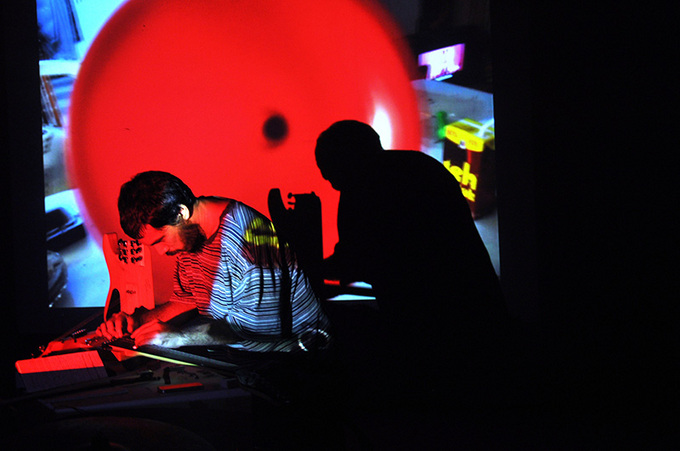
Performance by Bani Haykal (Singapore)
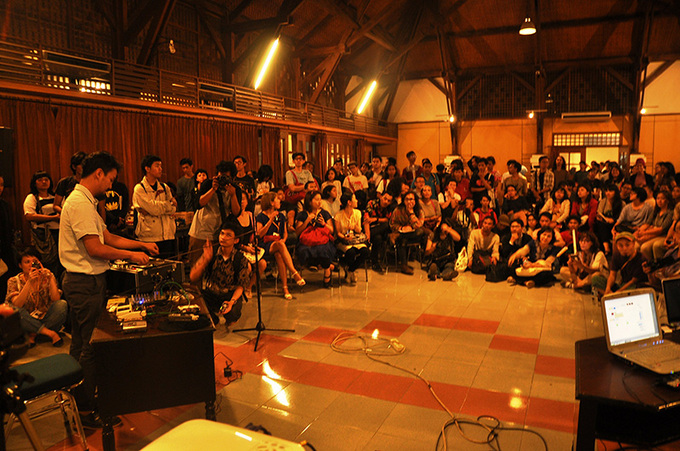
Performance by Duto Hardono (Indonesia) and Tad Ermitano (Philippines)
Finally, to Bangkok--A distinct approach to media between the four cities
The Bangkok exhibition, setting the main venue at the Bangkok Art and Culture Centre (BACC), provides a comprehensive look at the project as a whole. The main theme "Media Shapes Mind: Mind Shapes Choice: Choice Shapes Future" explores how we use media and technologies to enrich our lives. In addition to this, Japanese and Thai artists unveil a range of creative activities in their respective fields under several sub-themes.
In "Physical 3.0," for instance, the performance groups contact Gonzo (Japan) and B-Floor (Thailand) present the opening performance in a public space. In "Hacktivism," the groups of creators Rhizomatiks (Japan) and Apostrophy's (Thailand) produce a new piece of work.
Overall, it's interesting that the approach, or attitude, to media differs slightly between the four cities, mirroring the cultures of the different countries. The project "Media/Art Kitchen" starts out by affirming the position of media in any given social environment and situation, and explores the intersection between media and art, ultimately to discover how art might help to build and sustain that society in the future. It mixes and matches a diversity of existing events and circumstances, and seeks to create unique mechanisms and circuits through a process similar to ethical hacking.
A big hint to future societies--Think globally, and locally, too
The project website was not designed from scratch, either. We opted to use the Tumblr platform, since it's a universal service being versatile and easy to customize. We divided the site largely into two sections, which we call the A-side and the B-side. The A-side presents static information like the project outline, the concept, and artist profiles. This is displayed in a simple left-hand menu. The B-side makes use of the more typical Tumblr features: we upload images and videos of the process leading up to the project, and the posts are published instantly. This comes up in chronological order on the home page.
Because curators from as many as nine cities in seven countries are working on the project all at once, our tool--our medium--for communication is the English language. To indicate the global nature of the project, we chose the globally used font Helvetica. The exhibition logo is in Helvetica, too. Other than that, our rules are flexible: designs can be customized and edited by a curator in any city as he or she sees fit. We share only a simple framework, a minimal set of rules. This way, the originating city or setting can be distinguished, and even accentuated, purely by our choice of words and the images we upload. We believe this format can offer a big hint to societies of the future. It's the way to think globally, and locally, too.
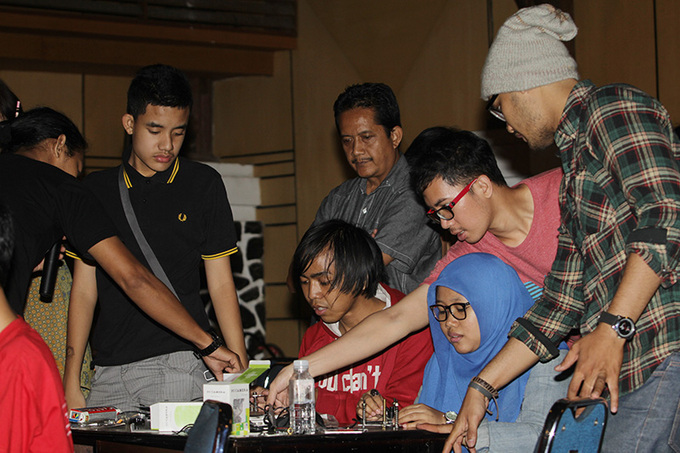
Making DIY microscopes in the workshop by Lifepatch (Indonesia)
Workshops and labs, not being as "supplementary"
In closing, let us explain the role of the workshops and labs. An ordinary exhibition displays art for the audience to appreciate, and holds related workshops and talk events as an add-on supplement. The curators of this project agree that the main event is the exhibition. Yes, we are out to showcase works of art. But what about the visitors? We believe they want to do more than passively appreciate art. They want to "experience" it. To do this, they need the chance to understand what they've seen, and express themselves in response to the inspiration they've been offered. The workshops and labs in this project are designed to be a natural extension of the exhibition, serving as a platform for human intellectual activities.
For instance, the Yamaguchi Center for Arts and Media, where one of the participating curators Daiya Aida works as chief educator, does not treat its educational programs as a mere add-on supplement to any exhibition. In planning a workshop, it designs the program carefully so that it can stand on its own as a strong museum-worthy function. With its view and effort, other cultural institutions actually request if they can incorporate it in their events. Also, the term "laboratory" originally means a special room or building in which experts conduct their research. But nowadays, with the Fab Lab movement, the definition has expanded to include spaces where even non-experts can share their knowledge, pursue creative projects and hobbies, and form new communities.
Opening up media art to broader interpretations
That said, in the beginning, "Media/Art Kitchen" also envisioned setting up labs as a creative platform, side by side with the exhibitions, and expected to have the variations in outcome to demonstrate the differences in "media culture" between the separate countries. As it turned out, though, we stretched to the max our interpretation of the lab function, and allowed diverse forms to emerge according to the situation in the country as well as the character of the venue and of the facilitating artists.
The three pillars of this project--exhibition, workshop, and laboratory--correspond to the audience's instinct to appreciate, understand, and express. Although we did lay down some basic rules, we more than welcome that the workshops and labs are echoing the creative bits of input from the local curators and artists, and expanding in all directions.
The challenge we took on in this project was a meaningful one. We've managed to show that media art is not a term with a narrow definition. We've proven that it represents the diverse ways of applying and using the media so closely linked with our lives and cultures. We've taken the first steps to opening it up to broader interpretations.
* From the editors: All photographs are from the Jakarta exhibition. Stay tuned for a series of reports from the other cities in subsequent issues.
Keiko Okamura
Curator, Tokyo Metropolitan Museum of Photography
Okamura was a curator at the Museum of Contemporary Art Tokyo (MOT) before taking her current position in 2007. Curatorial works include "MOT Annual 2000: Land/mind/body-scapes in the Age of Cold Burn" (2000), "Positioning--In the New Reality of Europe: Art from Poland, the Czech Republic, Slovakia and Hungary" (2005-06), and "Shinro Ohtake Zen-Kei: Retrospective 1955-2006" (2006).
Daiya Aida
Chief Educator, Yamaguchi Center for Arts and Media (YCAM)
Born in 1976, Aida is a graduate of Tokyo Zokei University and the Institute of Advanced Media Arts and Sciences (IAMAS). As chief educator at YCAM, he plans and executes workshops, gallery tours, and lectures in the fields of media and art.
Hiroyuki Hattori
Curator, Aomori Contemporary Art Centre (ACAC), Aomori Public University
Born in 1978, Hattori completed a graduate degree in architecture at Waseda University. Both professionally and in private, he plans and executes various experimental projects to produce spaces and infuse creativity into the ordinary based on architectural concepts. Towada Oirase Art Festival 2013, in which he participates as co-curator, is on until November 24, 2013.
Keywords
- Media
- Arts/Contemporary Arts
- International Exhibition
- Japan
- Indonesia
- Singapore
- Thailand
- Philippines
- Viet Nam
- Malaysia
- Media art
- Southeast Asia
- Curator
- Tokyo Metropolitan Museum of PhotographyYamaguchi Center for Arts and Media
- YCAM
- Aomori Public University
- Aomori Contemporary Art Centre
- ACAC
- Jakarta
- Kuala Lumpur
- Kuala Lumpur
- Bangkok
- Workshop
- Aomori
- Tokyo
- Yamaguchi
- OK. Video Festival
- Jakarta International Video Festival
- Ayala Museum
- Bangkok Art and Culture Centre
- BACC
- contact Gonzo
- B-floor
- rhizomatiks
- Apostrophy's
- tumblr
- Helvetica
- FabLab
Back Issues
- 2025.6. 9 Creating a World Tog…
- 2024.10.25 My Life in Japan, Li…
- 2024.5.24 The 50th Japan Found…
- 2024.5.24 The 50th Japan Found…
- 2024.5. 2 People-to-People Exc…
- 2024.5. 2 People-to-People Exc…
- 2023.12. 7 Movie Theaters aroun…
- 2023.6.16 The 49th Japan Found…
- 2023.4.24 The 49th Japan Found…
- 2022.12.27 Living Together with…


